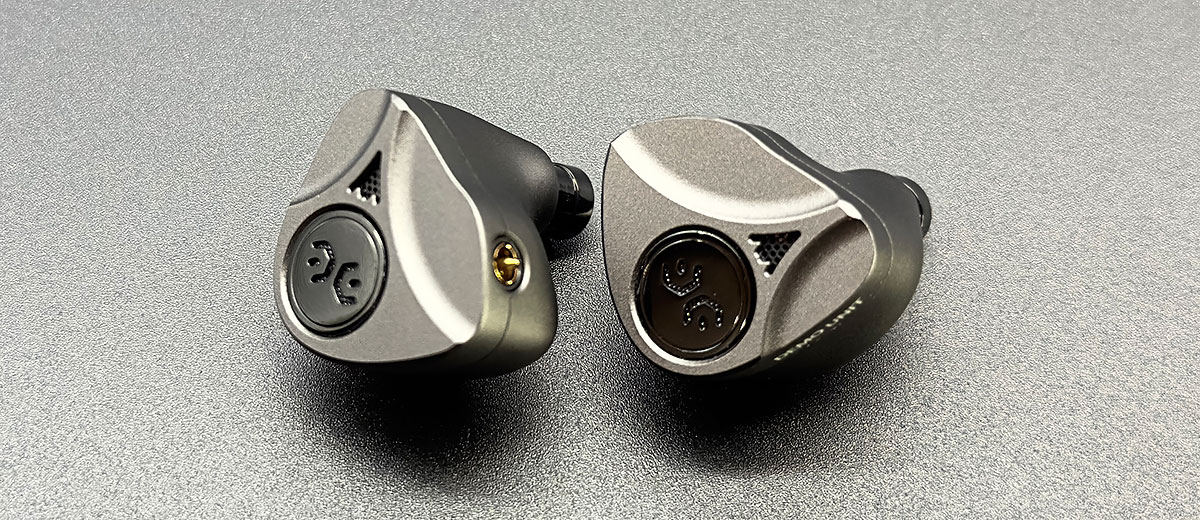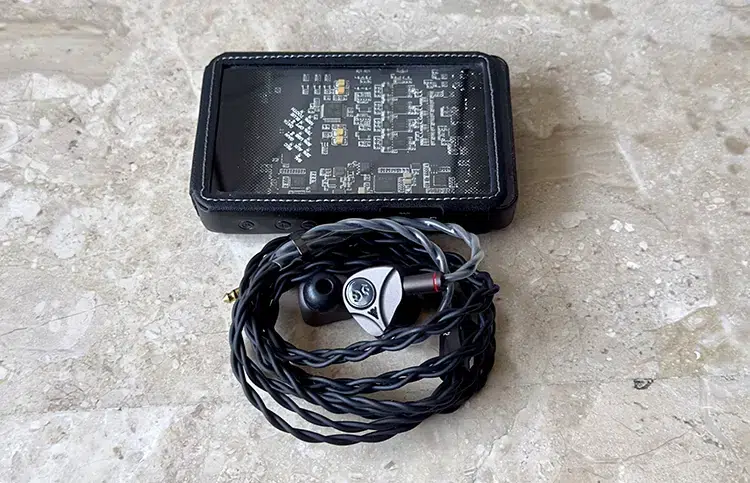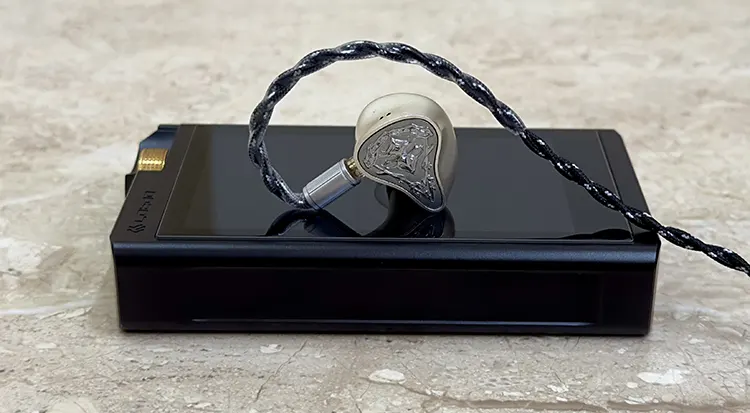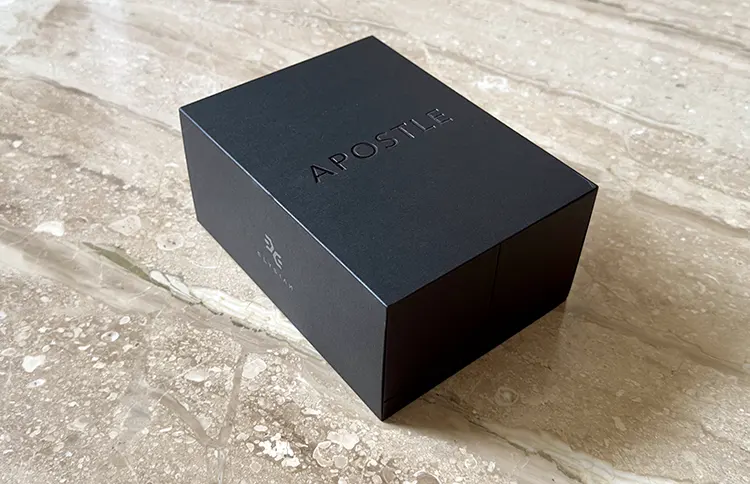Synergy
Efficiency
Elysian APOSTLE has an impedance of 10Ω @ 1 kHz and a sensitivity rating of 97 dB/Vrms. It does not require extra power and can be comfortably driven by low-power sources such as dongles and smartphones.
For reference, I drive APOSTLE at a volume level nearing 35 on my PAW Gold Touch. With higher-output sources, APOSTLE does not scale significantly but responds well, offering better stage presentation and a tighter bass range, which enhances the overall sound.
Another notable aspect is that it does not suffer from static noise issues with certain sources like the Questyle CMA18P and CMA18 Master, which typically exhibit such issues with most IEMs I’ve tried. The background remains dead silent.
Source Pairings
For APOSTLE, sources that are neutral or leaning bright are preferable. Any source that adds warmth can overwhelm the bass and midrange. For me, the most enjoyable pairings have been with the CMA18 Master and Astell&Kern SP3000.
On the LPGT, which slightly boosts the bass, the low end is enjoyable but can sometimes become overwhelming. The midrange retains a natural feel with decent warmth, as the LPGT leaves it mostly untouched.
In the upper midrange, there is some sharpness, but nothing concerning. Overall, the sound is airy and detailed, with the midrange taking center stage in this pairing. The stage presentation is well-balanced, offering satisfying depth and width.
With the Astell&Kern SP3000, the pairing with APOSTLE is quite impressive. APOSTLE truly shines in this pairing due to its highly resolving nature and more neutral approach compared to the LPGT.
The bass is tighter and does not overwhelm on most tracks I tried. The midrange leans slightly neutral but retains its timbre and sweetness.
In the treble region, there is more air and sparkle, leading to a better sense of instrument separation. The stage feels grander compared to the LPGT, with noticeable improvements in both width and depth.
The Questyle CMA18 Master pushes APOSTLE’s performance to the maximum. The IEM has undergone significant improvements, starting with a much wider and deeper stage. Layering and separation also see noticeable enhancements.
The bass is more controlled and tighter, eliminating the bloated or boomy bass that I occasionally encountered with the LPGT. There is ample airiness and sparkle in the top end, making for an engaging and immersive listening experience.
Select Comparisons
LETSHUOER Cadenza12 2024 Version
Technical
LETSHUOER recently refreshed their Cadenza 12 with a 2024 version. It is a universal in-ear monitor featuring a 12-driver setup, including one dynamic driver and 11 balanced armatures, with a mix of Sonion and Knowles drivers and a 6-way crossover.
The LETSHUOER Cadenza 12 has an impedance of 16Ω @ 1 kHz and a sensitivity rating of 110 dB/Vrms. Even if the Cadenza 12 does not demand additional power, it does benefit from a powerful source.
The Cadenza 12 has some scaling property that enables it to handle more powerful sources better. On my LPGT, it takes nearly 7-8 more volume clicks than the APOSTLE.
Design
The shells of the Cadenza 12 are made from titanium alloy, whereas the APOSTLE features aluminum alloy shells. The Cadenza is ergonomically designed with smooth edges but is more prone to scratches and attracting dirt. I prefer the matte shell of the APOSTLE, which is easier to maintain.
LETSHUOER has done a much better job if you only compare the unboxing experience. However, for me, it’s the APOSTLE that stands out with its minimal packaging and better accessories, especially the ear tips and small IEM pouches.
The Cadenza 12 connects via a 2-pin system, while the APOSTLE uses a more flexible Pentaconn system. I find the cable on both the IEMs nicely built and functional.
The modular stock cable on the Cadenza 12 is more rugged in build; in comparison, the APOSTLE’s stock cable is better at handling.
Performance
Even though the APOSTLE is significantly ahead in terms of bass quantity, it’s the quality of the Cadenza 12’s bass that stands out.
For me, APOSTLE’s bass is more about fun and excitement rather than quality. Cadenza 12’s bass, even if leaner, has decent texture and control.
Both sub-bass and mid-bass on APOSTLE have more impact and depth, helping the lower midrange with a thicker and more full-bodied presentation. In comparison, Cadenza 12 is leaner in this region but still has enough body to keep the sound engaging.
In the midrange, Cadenza 12 has a cleaner and more resolving profile, whereas the APOSTLE is slightly warmer and denser. If you seek a neutral and sharp midrange without missing any details, the Cadenza 12 may suit you better.
The APOSTLE, while feeling more musical, lacks some clarity and accuracy in the notes, which feel sharper on the Cadenza 12. In the upper midrange, both IEMs have good extension, but the Cadenza 12 carries a touch more energy and sharpness.
In the treble region, Cadenza 12 has a livelier presentation with more energy and detail, while the APOSTLE appears smoother and darker in comparison.
The details are more distinct on Cadenza, some of which may feel muted or less prominent on APOSTLE. Cadenza’s treble is airier, offering greater sparkle and shimmer. In the upper treble region, Cadenza 12 also has more headroom.
The soundstage on both IEMs has a similar width, while the APOSTLE does a better job with depth. Due to its cleaner timbre and airier sound, the Cadenza12 feels more open and less congested than APOSTLE.
Both IEMs deliver solid imaging, but the Cadenza 12 achieves greater accuracy. The Cadenza 12 is more resolving, bringing details to the forefront with greater clarity, which on APOSTLE are more subdued.
Nostalgia Audio NA12
Technical
The NA12 is a high-end studio reference IEM from the house of Nostalgia Audio. The tri-brid monitor packs 12 drivers, including 8 proprietary balanced armature drivers, dual electrostatic drivers, and the latest Sonion dual-membrane bone conduction vibrator with a 6-way crossover.
The dual bone conduction drivers are specifically tuned for enhancing the midrange frequencies, helping the vocals achieve better clarity and precision.
The NA12 is rated at 116 dB @ 1 kHz, 1 mW, and an impedance of 18Ω @ 1 kHz, making it as comfortable to drive as the APOSTLE.
The NA12, like the APOSTLE, does not have scaling abilities, so both of them do not ask for too much power. On my LPGT, the NA12 takes a lower volume level than the APOSTLE.
Design
The shells of the NA12 are crafted from resin and feature a deep red, single-tone color with a slightly transparent finish. They are larger than the usual resin shell IEMs we come across.
In comparison, the shells on the APOSTLE are built from aluminum alloy and are sturdier. For my ears, both IEMs fit comfortably without any issues.
The NA12 comes with two cables: one is a 3.5mm cable designed for studio monitoring, featuring a thin and supple build, while the other is a more premium 4.4mm high-purity silver-plated cable, which I mostly use. The stock cable on APOSTLE is better in build and performance.
Similar to the APOSTLE, the NA12 offers very thoughtful and durable accessories. I prefer the aluminum carry case that comes with the NA12 over the carry case of the APOSTLE. However, both are a bit cramped. Both IEMs include high-quality ear tips and mesh pouches for securing the shells.
Performance
The major difference in the tuning of both IEMs is how strong the bass is on APOSTLE, along with a more neutral midrange. NA12 is a lot warmer and slightly colored.
The bass on APOSTLE stands out with greater quantity, better texture, and layering. The boundaries are well-defined and remain more controlled on the APOSTLE, whereas on the NA12, they feel blurred at the edges.
Both the sub-bass and mid-bass have more presence and better clarity, whereas on the NA12, they can feel overall leaner in body. The lower midrange on both IEMs is well-bodied, adding enough weight to vocals and instruments.
In the midrange, NA12 has a warmer tone with some coloration, making it notably more musical. APOSTLE, even while taking a more neutral approach, does not lack emotion. It is the more resolving of the two.
Vocals on the NA12 are richer and fuller, though APOSTLE is not lagging far behind. In the upper midrange, both are nicely extended; however, APOSTLE takes the lead with more detail and better extension.
In the treble region, the APOSTLE presents better detail. NA12 has a more rolled-off treble and lacks air and sparkle. It is the smoother of the two and takes a more relaxed approach.
On the NA12, treble notes decay quicker and are often muted, delivering fewer details. In the upper treble region, APOSTLE offers more air and provides a greater sense of openness and space overall.
The APOSTLE’s stage stretches wider and deeper, while the vertical height is better on NA12. The APOSTLE is better in imaging, as spatial cues are better depicted. It is the more resolving of the two, delivering micro-details more vividly.
Kinera ThorKing
Technical
Kinera ThorKing is a recently released flagship IEM from Kinera. It has a tri-brid setup that includes 1 dynamic driver, 6 Knowles balanced armature drivers, and 4 Sonion electrostatic drivers. Additionally, a four-way crossover implementation ensures precise frequency distribution among the drivers.
Kinera ThorKing has an impedance of 10Ω @ 1 kHz and a sensitivity rating of 105 dB/Vrms. The IEM can be comfortably driven by sources with fewer power specifications, such as dongles and smartphones. ThorKing takes a few volume clicks more than the APOSTLE on my LPGT.
Design
ThorKing has a premium design, featuring matte brass shells with a highly intricate faceplate.
The faceplate design is inspired by Norse mythology, depicting the legendary battle between Thor and Jörmungandr. A polished silver version of the IEM is also available, but I am sure it would be prone to scratches.
The shells have an ergonomic shape with smooth edges, ensuring a comfortable fit. The nozzle length is moderate, with an average width. In comparison, the APOSTLE has a bigger nozzle; however, the fit is never an issue with either IEM.
ThorKing connects via a 2-pin, 0.78mm socket, while the APOSTLE connects via a Pentaconn system. The stock cable on the ThorKing is decent enough, but given the premium price tag, I expected something better. I find the stock cable on the APOSTLE better in terms of build, design, and performance.
There is no comparison in the packaging and unboxing experience, as Kinera has put in a massive effort. ThorKing has a grand presentation, whereas the APOSTLE opts for a very minimalistic approach. However, both IEMs come with quality accessories, so it’s a tie.
Performance
ThorKing and APOSTLE differ in several aspects, with APOSTLE offering a fuller bass presence, while ThorKing does a better treble.
ThorKing’s bass has less impact but retains the qualities of a well-textured and intricately layered bass. When called for, the bass on ThorKing kicks in effectively, making its presence prominent.
APOSTLE has a thicker bass with a deep, rumbling sub-bass, which sometimes overwhelms the mix. The mid-bass is also more pronounced on the APOSTLE, but overall, the bass lacks some refinement and control.
In the midrange, both IEMs follow a neutral approach. Due to the thicker bass shelf on the APOSTLE, the midrange is slightly overshadowed, whereas it remains cleaner and sharper on ThorKing.
Both IEMs feature a natural and rich vocal range, with APOSTLE offering a slightly thicker and more full-bodied presentation. Instruments and vocals extend well towards the upper midrange, where both exhibit a touch of sharpness but never become harsh.
In the treble region, ThorKing leads ahead with a more open and detailed treble response. It reveals microdetails more effectively, making instruments like cymbals, strings, and high-pitched vocals sound clearer and more articulate.
APOSTLE’s treble is smoother but lacks the openness that ThorKing offers. ThorKing’s treble carries more energy and shimmer, enhancing the excitement, whereas APOSTLE is more restrained in comparison.
ThorKing presents a wider soundstage than APOSTLE, while the latter has more depth. Imaging is slightly more precise on ThorKing due to its more defined spatial presentation. Instrument separation is also more distinct on ThorKing.
Those who appreciate a cleaner timbre and a well-extended treble range will likely prefer the ThorKing, while those seeking a fun, energetic sound with a strong bass presence will be more drawn to the APOSTLE.
My Verdict
In the past, I briefly spent time with some of Elysian’s IEMs, including the Elysian PILGRIM and PILGRIM:NOIR. To be honest, I liked the tuning and gained a good understanding of Elysian’s sound signature.
Having heard a lot about the ANNIHILATOR 2023, my expectations for the APOSTLE were high. Over the past few weeks, I have spent considerable time with this new IEM. I think Elysian has done a decent job with the APOSTLE’s tuning. But was I completely blown away? Probably not.
For those who prefer a fun and engaging sound, the APOSTLE serves well and performs admirably across various genres. There are some areas where it falls a bit short. I would have preferred a cleaner, airier presentation with a tighter and less pronounced bass response.
In its price range, there are strong competitors, too, such as the Cadenza 12. I recommend trying the APOSTLE before purchasing, as it may suit some listeners perfectly while not being the best fit for others. The choice of source is also crucial.
That said, I appreciate the overall package, from the IEM’s solid build to the thoughtful accessories included. I truly enjoyed my time with the APOSTLE.
Elysian Acoustic Labs APOSTLE Specifications
- Driver Configurations: 1 x 10mm LSR Dynamic Driver, 1 Knowles balanced armature, 1 Sonion balanced armature, 2 Sonion ESTs
- Frequency Response: 20 Hz – 40 kHz
- Impedance: 10 Ω @ 1 kHz
- Sensitivity: 97 dB @ 100 mV @ 1 kHz
- Cable: Customised 19 AWG Copper, Hybrid Silver, and Gold-Plated Copper Cable
- Connector: Pentaconn Ear
- Terminator: OFC 4.4mm
- Ear tips: Divinus Velvet Ear tips












